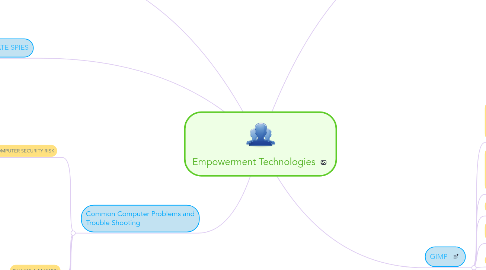
1. Mind Mapping
1.1. “A mind map is a type of spider diagramor concept map that consists of a centralized subject and related topics or ideas branching off from it in all directions. From each topic subtopics can again branch off, resulting in a radiant structure.”
1.2. If you want them to be read in a certain order, start at about one o’clock and go clockwise around the center - this is the direction mind maps are generally read.
2. Common Computer Problems and Trouble Shooting
2.1. COMPUTER SECURITY RISK
2.1.1. CYBERCRIME
2.1.1.1. Refers to an online or Internet based illegal acts.
2.1.2. HACKER Some one who accesses a computer or network illegally. Hackers often claim the intent of their security breach is to “improve security”
2.1.3. SCRIPT KIDDIE Often are teenagers who use pre-written hacking and cracking programs to break into computers
2.1.4. CYBER EXTORTIONIST Uses e-mail as a medium for extortion. They send e-mail messages indicating they will expose confidential information, exploit a security flaw or launch an attach if not paid a sum of money
2.1.5. CYBER TERRORISM Someone who uses the Internet to destroy or damage computers for political reasons (eg. Destroy the traffic system, telecommunications infrastructure, etc.)
2.2. INTERNET ATTACKS
2.2.1. •VIRUS- altering the computer works without user’s knowledge or permission
2.2.2. •WORM- program that copies itself repeatedly
2.2.3. •TROJAN HORSE- program that hides within a legitimate program and is triggered by an action
2.3. PROTECT YOURSELF
2.3.1. Never open an email attachment that is not from a trusted source
2.3.2. Install an Anti-Virus Program for ALL your computers and update on a regular basis
2.4. COMPUTER PROBLEMS
3. CORPORATE SPIES
3.1. Hired to break into a specific computer and steal its proprietary data and information to gain competitive advantage
4. GIMP
4.1. GIMP is a cross-platform image editor available for GNU/Linux, OS X, Windows and more operating systems. It is free, open source image manipulation program for photo retouching, image composition and image authoring.
4.2. Image manipulation programs allow you to create and customize graphics from preexisting images, or make one from scratch. Programs like these provide a wealth of tools designed to manipulate and tweak images, allowing you to position and transform them, and add text and effects
4.3. Share — copy and redistribute the material in any medium or format
4.4. Adapt — remix, transform, and build upon the material for any purpose, even commercially
4.5. Creating a New File
4.5.1. Ctrl+N
4.5.2. empty canvass
4.6. Open an Existing File
4.6.1. Ctrl+O
4.7. Format
4.7.1. JPEG (Joint Photographic Experts Group)
4.7.2. PNG (Portable Network Graphics)
4.7.3. GIF (Graphics Interchange Format)
4.8. LAYERS
4.8.1. Layer as a transparent piece of film with an image on it. You can stack these pieces of film on top of each other to form a new image!
4.8.2. Layer Mask that acts like a filter, allowing you to modify or add an effect to only a small region of the Layer
4.8.3. Shift+Ctrl+N
